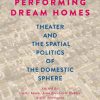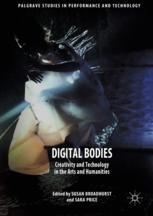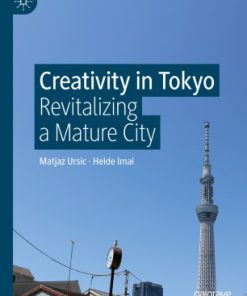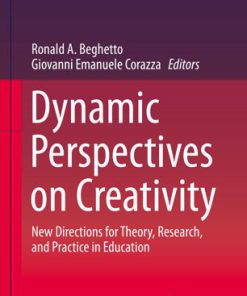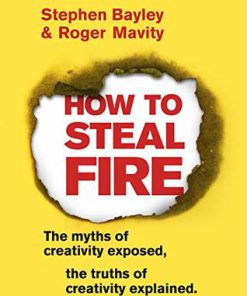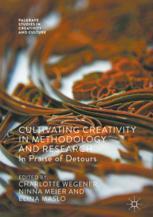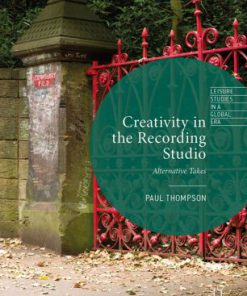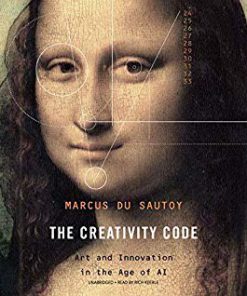Creativity and the Performing Artist Behind the Mask 1st Edition by Paula Thomson, Victoria Jaque ISBN 0128041080 9780128041086
$50.00 Original price was: $50.00.$25.00Current price is: $25.00.
Creativity and the Performing Artist Behind the Mask 1st Edition by Paula Thomson, Victoria Jaque – Ebook PDF Instant Download/Delivery: 0128041080, 9780128041086
Full download Creativity and the Performing Artist Behind the Mask 1st Edition after payment
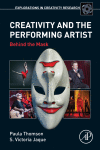
Product details:
ISBN 10: 0128041080
ISBN 13: 9780128041086
Author: Paula Thomson, Victoria Jaque
Creativity and the Performing Artist: Behind the Mask synthesizes and integrates research in the field of creativity and the performing arts. Within the performing arts there are multiple specific domains of expertise, with domain-specific demands. This book examines the psychological nature of creativity in the performing arts. The book is organized into five sections. Section I discusses different forms of performing arts, the domains and talents of performers, and the experience of creativity within performing artists. Section II explores the neurobiology of physiology of creativity and flow. Section III covers the developmental trajectory of performing artists, including early attachment, parenting, play theories, personality, motivation, and training. Section IV examines emotional regulation and psychopathology in performing artists. Section V closes with issues of burnout, injury, and rehabilitation in performing artists.
- Discusses domain specificity within the performing arts
- Encompasses dance, theatre, music, and comedy performance art
- Reviews the biology behind performance, from thinking to movement
- Identifies how an artist develops over time, from childhood through adult training
- Summarizes the effect of personality, mood, and psychopathology on performance
- Explores career concerns of performing artists, from injury to burn out
Creativity and the Performing Artist Behind the Mask 1st Table of contents:
Section I: Creativity Theory and Performing Artists
1. Understanding creativity in the performing arts
Abstract
Definitions and expert evaluations
Integrative models
Heuristic assessment: three-dimensional and geneplore models
Componential model of creativity
The Darwinian evolutionary theory of creativity
Investment and propulsion theory
Distributed creativity theory
Social network theory and small world groups
Systems model
Complexity theory and creativity classification system
Summary
Concluding remarks
2. Domains in the performing arts
Abstract
Introduction: domain-general and domain-specific creativity
Interpreters, generators, and intermediaries
Performing arts domains/fields
Dance
Media arts
Music
Opera
Theater
Performing artists working outside the five primary NEA fields
Performance art
Summary
Concluding remarks
3. The person: Talent and performing artists
Abstract
Talent or giftedness
Pyramid of talent development model and three-ring model
Multiple intelligences
Theory of positive disintegration
The five overexcitabilities
Talent-development mega-model
Summary
Concluding remarks
4. Creative experiences
Abstract
Introduction
Interpreters and the creative process
Rehearsal and the creative process
Performing a character
Performing noncharacter works
Experiencing the creative process
Summary
Concluding remarks
5. Imagination and fantasy
Abstract
Imagination
Fantasy and fantasy proneness
Employing imagination and fantasy
Summary
Concluding remarks
Section II: Biological Manifestations of Creativity in Performing Artists
6. Neurobiology, creativity, and performing artists
Abstract
The brain
Functional neural networks
Measuring brain activity
Generative and evaluative modes of creativity
Cognitive processes: divergent, convergent, insight, and working memory
Neuroaesthetics and performing arts
Mirror neurons and creativity in the performing arts
The body and creativity: real-time creative action
Neurofeedback training and the performing artist
Summary
Concluding remarks
7. Physiology and creativity
Abstract
Introduction
Physiology and creative stress: a dynamic process
Cardiac and respiratory systems and performance
Autonomic nervous system
Heart rate variability and creativity
Emotional expressivity and autonomic nervous system physiology
Physiological performance demands
Musculoskeletal systems and kinesthetic creativity
Fitness and performers
Enhancing physiological conditioning
Summary
Concluding remarks
8. Flow and neurophysiological responses
Abstract
Introduction
Embodied flow, genetic heritability, and flow proneness
Neuroscience and flow experiences
Neurochemistry and flow experiences
Physiology and flow experiences
Neurophysiological approaches to enhance flow experiences
Summary
Concluding remarks
Section III: Development of the Performing Artist
9. Early development
Abstract
Introduction
Erik Erikson’s psychosocial model of development
Prenatal development and epigenetics
Trust versus mistrust
Autonomy versus shame and doubt
Initiative versus guilt
Industry versus inferiority
Group identity versus alienation
Individual identity versus identity confusion
Creativity development through the lens of other theorists
Summary
Concluding remarks
10. Play and theory of mind
Abstract
Introduction
Social development and educational support
Performing arts: worldplay and other talents
Play benefits in the performing arts
Theory of mind
Neurobiology and theory of mind
Performing artists and theory of mind
Summary
Concluding remarks
11. Attachment, parenting, and childhood adversity
Abstract
Introduction
Infant and adult organized attachment classifications
Parenting styles, attachment, and creativity
Performing artists, parenting, and attachment patterns
Musicians
Actors
Dancers
Adverse childhood experiences, disorganized attachment, and performing artists
Summary
Concluding remarks
12. Personality and motivation
Abstract
Personality
Motivation
Summary
Concluding remarks
13. Training the performing artist
Abstract
Introduction
Training creativity
Deliberate practice and other factors leading to expertise
Training practices within domain-specific fields
Summary
Concluding remarks
Section IV: Emotion: Regulation, Resilience, and Pathology
14. Self-regulation, emotion, and resilience
Abstract
Self-regulation
Organize–disorganize–reorganize: the role of self-regulation in the creative process
Temperament
Temperament, attachment, and self-regulation
Stimulus hunger: temperament, overexcitability, and flow
Coping strategies under stress
Emotion regulation
Resilience
Summary
Concluding remarks
15. Mood and creativity in the performing artist
Abstract
Introduction
Mood and creativity
Physiology, neurobiology, and mood
Empathy, passion, rumination, and mood
Mood in music, dance, and acting
Summary
Concluding remarks
16. Unresolved mourning and posttraumatic stress disorder in performing artists
Abstract
Introduction
What are posttraumatic stress disorder and unresolved mourning?
Trauma, trauma reminders, and performance: effects on physiological and neurobiological systems
Effects of chronic stress
Trauma and self-harm
Shame and performing artists
Performing artists: PTSD, unresolved mourning, and shame
Trauma and resilience
Recall of trauma: testimony theater/theater of witness
Working with performing artists with PTSD
Summary
Concluding remarks
17. Performing artists and psychopathology
Abstract
Introduction
Vulnerability, resilience, and stereotypes of mental illness
Psychotic disorders: schizophrenia, schizotypy, and bipolar disorder
Dissociation, maladaptive daydreaming, and excessive fantasy proneness
Anxiety and performers
Depression
Joint hypermobility and psychopathology
Obsessive-compulsive disorders, eating disorders, body image, and perfectionism
Chronic pain, insomnia, substance abuse, and suicidality
Treating psychopathology in performing arts
Summary
Concluding remarks
Section V: Professional Reality of a Performing Artist
18. Careers in the performing arts
Abstract
Protean careers and job satisfaction
Resilience and career success
Serendipity in a performing arts career
Unions, guilds, and working conditions
Environmental challenges in the workplace
Performing arts entrepreneurship
Careers and anxiety
Diversity and stereotypes
Challenges and abuse in a performing arts career
Aging, retirement, and career endings
Summary
Concluding remarks
19. Injuries and rehabilitation
Abstract
Introduction
Injury and the effects on creativity
Injury safety policies and workers’ compensation
Injury prevalence and severity
Pain appraisal and coping
Hypermobility condition and injury vulnerability
Overuse, overtraining, and fatigue
Unique injury profiles in performing artists
Injury patterns in specific performing arts domains
Rehabilitation practices
Summary
Concluding remarks
20. Health concerns and burnout
Abstract
Introduction
Hypermobility condition, dysautonomia, and health concerns
Cumulative wear and tear, hearing loss, and health problems
Scoliosis, dystonia, and neurological disorders
Respiratory and cardiovascular disease
Skin disorders
Vocal disorders
Genitourinary conditions
Pregnancy and endocrine control related to menstrual cycles
Malignancies and cancer
Liver-related diseases, hepatitis, and infectious diseases
Inflammatory and autoimmune diseases
Somatoform disorders and health care
Burnout
Treatment and wellbeing
Summary
Concluding remarks
Conclusion/Epilogue
Creativity and performing arts: constraints and future recommendations
People also search for Creativity and the Performing Artist Behind the Mask 1st:
creativity and the performing artist
creative artist jobs
creative artist activities
creative artists examples
creative arts and performing arts
Tags:
Paula Thomson,Victoria Jaque,Creativity,Performing Artist,Mask
You may also like…
Arts - Performing Arts
Digital Bodies: Creativity and Technology in the Arts and Humanities 1st Edition Susan Broadhurst
Education Studies & Teaching - School Education & Teaching
Engineering - Social & Cultural Aspects of Technology
Uncategorized
How to Steal Fire The Myths of Creativity Exposed The Truths of Creativity Explained Stephen Bayley
Politics & Philosophy
Politics & Philosophy - Anthropology
Creativity in the Recording Studio: Alternative Takes Paul Thompson
Reference - Writing
Computers - Computer Science
The Creativity Code Art and Innovation in the Age of AI Marcus Du Sautoy


